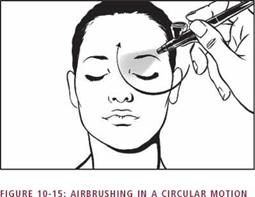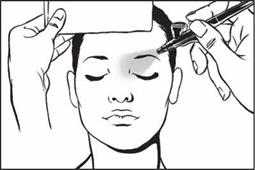by Bradley Look
People ask me all the time of the dangers of airbrushing. There is an unfounded fear about the airbrush. What I usually find is
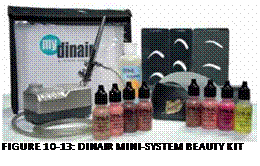 dispersed in water. Water is the most common solvent found in cosmetics, and is usually referred to as aqueous dispersion.
dispersed in water. Water is the most common solvent found in cosmetics, and is usually referred to as aqueous dispersion.
Polymer-Water-Based: This cosmetic formulation is one of the more commonly used for airbrush makeups. Once the makeup is airbrushed, the polymer vehicle upon drying produces a continuous film on the skin.
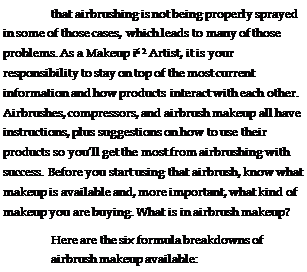
![]()
![]()

![]()


 |
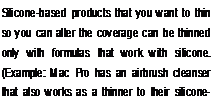 |
 |
Polymer-SD40-Alcohol Based: This is just like the polymer-water-based formulas (as listed above), with one major difference. SD40 alcohol is used as the solvent in place of water. The alcohol assists in the drying of the product on the skin.
Alcohol Based: This type of airbrush makeup is normally known within the makeup industry as the “temporary airbrush inks” associated with the production of faux flesh art (tattoos).
Silicone Based: This is the newest formula of all the airbrush makeups currently available. This brand of cosmetic claims that it stays looking “just applied” all day without fading or wearing away.
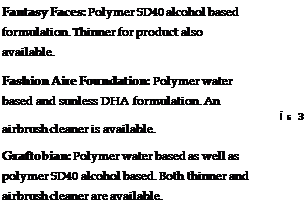 DHA Based: Although technically not really considered an airbrush makeup, DHA (dihydroxyacetone) based products constitute the sunless-tanning systems. The use of the airbrush in spraying cosmetics gave the sunless-tanning manufacturers an idea: Why not produce a formula that can be atomized?
DHA Based: Although technically not really considered an airbrush makeup, DHA (dihydroxyacetone) based products constitute the sunless-tanning systems. The use of the airbrush in spraying cosmetics gave the sunless-tanning manufacturers an idea: Why not produce a formula that can be atomized?
Now let’s talk about makeup and what is on the market today. Products are listed by their brand name and/or by the manufacturer’s name. All of the products listed are prereduced to a consistency for spraying straight from the bottle. However, if you should desire to thin the product further, check with the manufacturer first. Also, these products have been formulated to be atomized at a low PSI (pounds per square inch), usually between 3 and 6. Using the right product for the right job means a good makeup.
Airbrush Bodyart: Airbrush product available in both water and alcohol formulations. DHA tanning system offered as well.
Airmakeup Cosmetics: Polymer water based product.
AirPro Airbrush Makeup: A water-based formula. The company also has a sunless – tanning solution. Airbrush cleaner available for line.
Air Craft: A water-based formula.
Bodyair: Polymer water based line of products.
DCK Airbrush Cosmetics: Polymer water based product line.
Dinair: There are three product lines available through this company: polymer water based, polymer SD40 alcohol based, and DHA. An airbrush cleaner is also manufactured.
Duratat: A water-based tattoo ink containing no alcohol.
JanTana: DHA sunless tanner. Jomo: SD40 alcohol based.
Kett Cosmetics: Water based and polymer SD40 alcohol based. An airbrush cleaner is also available.
KRYOLAN: Currently, kryolan has a polymer water based and an SD40 alcohol based product line.
MAC Airbrush: Polymer water based and silicone SD40 alcohol based.
Make Up For Ever: Water alcohol based.
Mancini Airbrush Makeup: Water based and offers an airbrush cleaner.
Marvaldi Makeup: Water-based formulation.
Michael Davy Airbrush Makeup: Polymer SD40 alcohol based.
 Mist Mirage: Silicone SD40 based, as well as DHA sunless formula. An airbrush cleaner is also available.
Mist Mirage: Silicone SD40 based, as well as DHA sunless formula. An airbrush cleaner is also available.
O2 Cosmetics: Water-based formula. Also available in a DHA sunless tanner.
Obsessive Compulsive Cosmetics: Water based and SD40 alcohol based.
Reel Creations Body Art Inks: SD40 alcohol based line.
Safari Airbrush Makeup: Polymer-alcohol – based formula. DHA sunless tanner also in і 6 4 the line.
Skin Illustrator Colors: SD40 alcohol based formula line.
Stacolors: SD40 alcohol based product line.
Su-do Body Art: Polymer water based,
SD40 alcohol based, and DHA in product line. Airbrush cleaner available.
Temptu: Water based, polymer water based, polymer SD40 alcohol based, and silicone SD40 based. An airbrush cleaner is also available in the line.
Totally Tattoo Party Body Paints: Polymer water based.
Trendy Tribals: Polymer water based.
uslu airlines: Polymer water based.
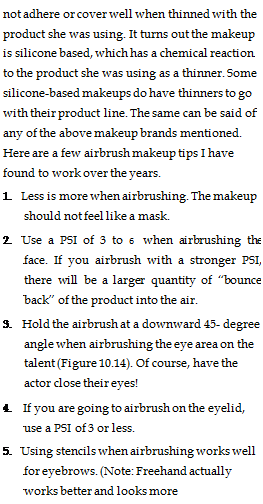
 Remember to keep in mind that not all brands interact well with each other. So don’t try mixing together two different manufacturers’ product lines—their chemistry may not be compatible. A classic example is thinners. A Makeup Artist wrote to me to say she was having a hard time applying a certain makeup brand that would
Remember to keep in mind that not all brands interact well with each other. So don’t try mixing together two different manufacturers’ product lines—their chemistry may not be compatible. A classic example is thinners. A Makeup Artist wrote to me to say she was having a hard time applying a certain makeup brand that would
